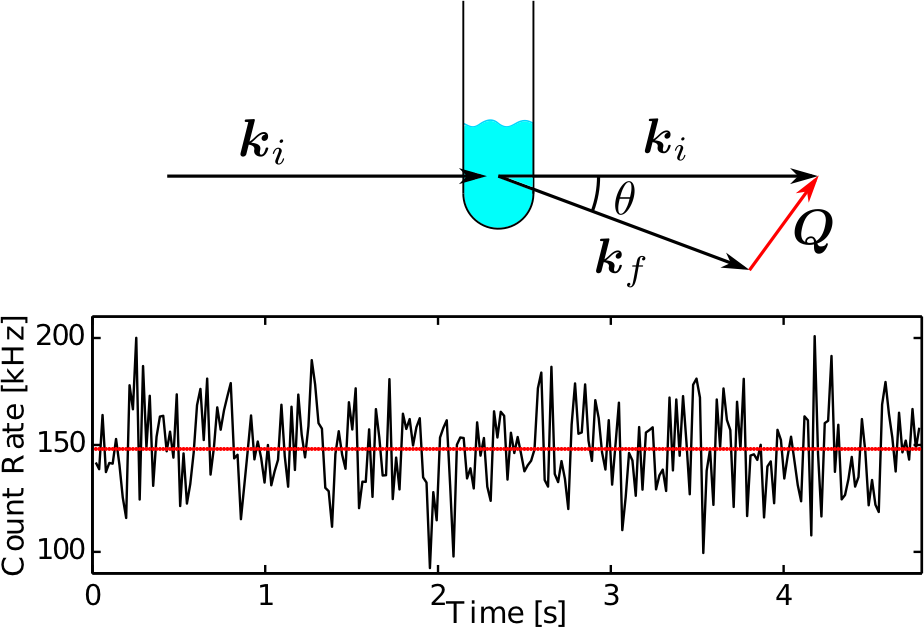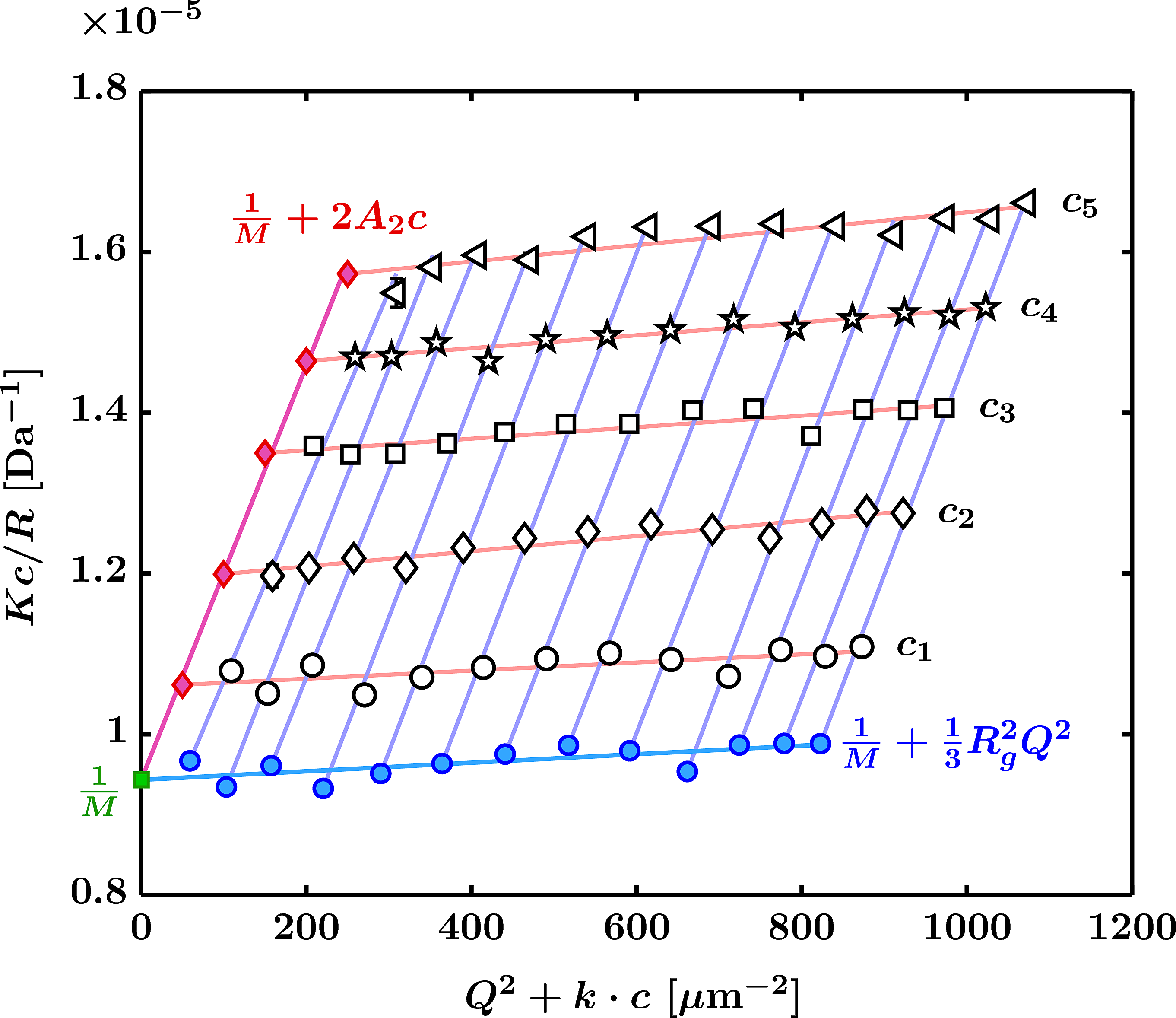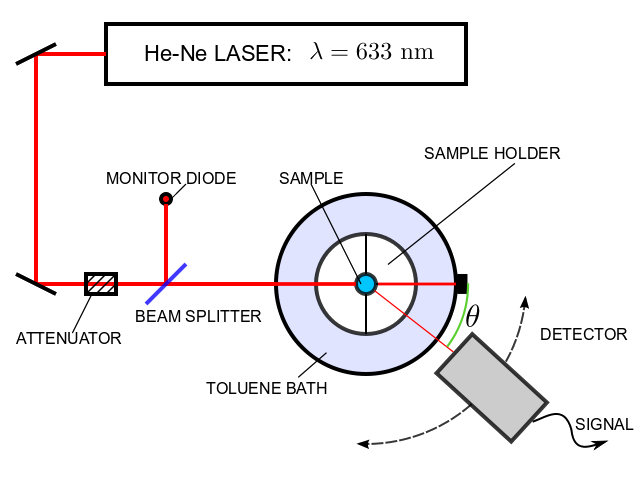Static and Dynamic Light Scattering (SLS/DLS)
Light scattering is a well established technique to investigate
properties of particles in solutions. Information such as size,
molecular weight, diffusion and interaction strength are
obtained. The basic principle is that a laser beam impinges on a
sample and the scattered intensity is probed at a certain angle
θ by a detector.
|
From the intensity fluctuations in time (see Figure 1),
information on the dynamics within the solution are
obtained. The evaluation of the fluctuations is commonly
named as dynamic light scattering (DLS) while the analysis
of the absolute mean intensity is known as static light
scattering (SLS). The intensity is very sensitive to
variations in size of the solutes, so that it is
advantageous to investiagte aggregation in solution.
The scattering vector Q is defined as difference between
outgoing and incoming wave vector and its magnitude is

|

Figure 1: Scattering geometry and intensity
fluctuations at detector
|
The main quantities influencing the static light scattering
intensity, are the molecular weight M, concentration and
size of the particles in solution. Due to the long wavelength,
particles of size of nanometers (typical for proteins) can be
interpreted as (independent) scattering centers whose intensity
interferes constructively. If the particles are big enough
(>λ/20), an angle dependent change in intensity can be
observed. The Rayleigh ratio R ∝ Is is
introduced as quantity independent of the experimental setup.
To have a direct estimation of the results, the scattering
intensity is normalized by the solute concentration c and
reduces for small concentration to
 Where A2 is called second virial coefficient
describing the interactions between the particles, Rg
is the radius of gyration and K is an optical constant
Where A2 is called second virial coefficient
describing the interactions between the particles, Rg
is the radius of gyration and K is an optical constant

If the particles are big in size or interacting strongly,
further angular and concentration dependent corrections have to
be considered, arising from the form and structure factor
(e.g. see SAXS).
In DLS
the motion of particles is probed by analyzing the correlation
of intensity fluctuations.
The decay of the normalized intensity correlation
function g(2)(τ) yields the diffusion
coefficient D of the solutes by the so called
Siegert relation

|
|
Description
The laser beam passes through a beam splitter in order to
detect a reference intensity at the monitor diode. In transmission
it impinges on a glass cuvette immerged in a toluene bath. This
bath avoids reflexes and its temperature can be controlled
accurately. The beam scattered by the sample is detected at an
angle θ by an avalanche photo diode (APD) transferring the
signal to a PC. The purpose of the attenuator is to protect the
APD from a too high photon flux.
Technical specifications [1]:
Instrument : ALV-CGS-3
Angular Range : [17° - 150°]
Correlator : Multiple Tau 7004 /Fast Autocorrelator
Sampling Time Range : [100 ns - 3435.9 s]
Wavelength : λ= 632.8 nm
|
|
|
DLS gives the possibility to separate particles which differ
in their diffusive behavior. An example is displayed in
Figure 3, where gold colloids and latex beads which differ
by a factor of 20 in radius have been measured. From a
CONTIN analysis or equivalently a double exponential fit,
the diffusion constants and hydrodynamic radii can be
extracted.
|
|
SLS results of polystyrene particles, measured at
multiple angles and varying concentration are shown in
Figure 4 as a Zimm plot. This plot yields intuitively
the values of the radius of gyration, second virial
coefficient and molecular weight. For the sample studied
in Figure 4 a molecular weight of 106 kDa is gained in
good agreement with the nominal weight of 100 kDa.
|

Figure 4: Zimm plot of polystyrene 100 kDa
|
References
[1] R. Peters. ALV - Technical Documentation, 2009.



